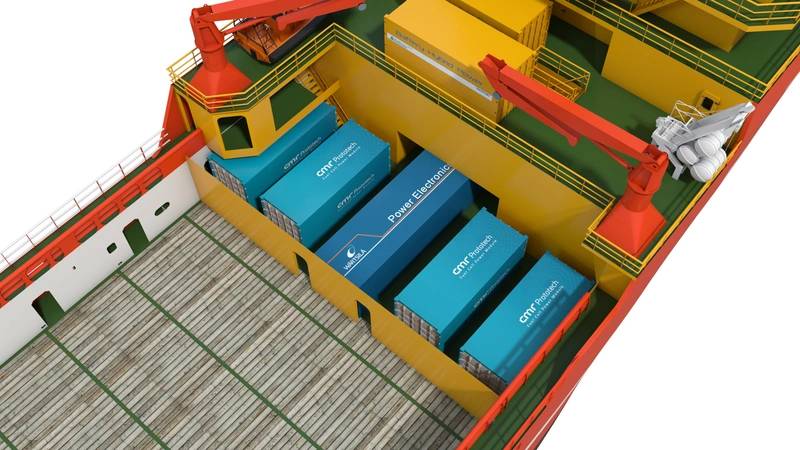
Interest in ammonia-powered fuel cells for the maritime sector is growing, but stakeholders have been hesitant to commit to investments in large-scale systems. Now the ShipFC project is aiming to secure a place for ammonia in the future of deep-sea shipping.
The project will equip the offshore supply vessel Viking Energy, owned and operated by Eidesvik and on contract to energy major Equinor, with a 2-megawatt (MW) ammonia fuel cell, allowing it to operate for at least 3,000 hours annually on clean fuel. Following the completion of that phase, the project will ramp up to qualifying 20MW fuel cell solutions for oceangoing vessels.
“The ultimate goal of the project is to demonstrate the feasibility of ammonia fuel cells for ocean-going vessels and long sea voyages,” says Dr. Michail Cheliotis, Research Associate at the University of Strathclyde, lead partner in the project. “Once the first phase of the project is completed, that’s when the fun starts.”
Apples and oranges
“The huge difference in scope makes ShipFC much more interesting than just a replication of Viking Energy,” says Cheliotis. “The similarities basically end with ammonia, because a 20MW power plant requires significantly different treatment.” That said, he assures that scaling up the project is seen to be well within reach, given the prior knowledge of both fuel cells and ammonia as an energy carrier.
The project will consider three replicator vessel types, including a bulk vessel, an offshore construction vessel, and a container ship. Cheliotis tells that the work will involve close cooperation with replicator vessel owners and a thorough examination of vessel requirements.
A known commodity
Technical and economic knowledge developed in the Viking Energy pilot will be incorporated in a broader analysis of ammonia in the maritime sector and comparison with other alternative fuels.
“Ammonia presents certain technical challenges, but even though it is corrosive, the safety trade-off between ammonia and hydrogen favors ammonia,” says Cheliotis. “It is less explosive, requires less complex storage and transport solutions, and it is a well-known commodity from industry. Based on this experience, the necessary safeguards can be built in.”
Experience with gas fuels will be a significant building block, he adds: “We have seen that liquid ammonia is similar to liquefied gas in the handling process. Industry has a high level of maturity and an excellent track record in handling LNG and LPG, and this experience is proof that it can be done safely.”

Considering all the Steps
ShipFC will closely examine the ammonia supply chain, Cheliotis reports. “We will be looking at the entire life cycle of ammonia, from production to transport and bunkering. One of the ShipFC partners is a major supplier of ammonia, and we will be working together with them to address these issues.”
Ammonia for fuel cells can be produced with a green profile, Cheliotis explains, giving ammonia a positive overall environmental footprint: “Ammonia can easily be made from renewable resources, making it one of the fuels that will likely meet part of shipping’s future green energy demand.”
Strathclyde will also provide maritime safety analysis for onboard solutions. “Part of our work will be to propose new safeguards and accommodations for marine installations of this size,” Cheliotis tells.
Ammonia + fuel cells = efficiency
The efficiency of ammonia in fuel cells is good, Cheliotis says. “Successful cases have taken advantage of the most efficient fuel cells. We believe that we can hit the sweet spot of fuel cell technology with ammonia.”
Fuel cells have favorable characteristics in the configuration of vessels as well, he says. “As they do not require the same dedicated space as large two- or four-stroke engines, fuel cells can be distributed in modules, saving space and exploiting otherwise unavailable options.”
The time is ripe
“People are ready to listen to arguments for fuel cells. The technology is becoming more common, and stories of success from other projects in road and rail are getting media attention,” Cheliotis observes. “Now we want to take advantage of fuel cell momentum and examine the use of ammonia in addition to hydrogen.”
Cheliotis sees the relationship between hydrogen and ammonia in fuel cells as more complementary than competitive: “This is simply because different solutions will be required to meet different challenges. The choice of solution will depend on a case-by-case evaluation,” he believes.
Solving the ammonia–fuel cell equation for deep-sea shipping is a step in the right direction for ensuring progress in the decarbonization process, Chiliotis concludes. “We will need many solutions to meet diverse needs in the maritime industry, and fuel cells powered by ammonia can be among them.”
ShipFC project partners:
The University of Strathclyde (UK) and National Centre for Scientific Research Demokritis (GR) will assess safety criteria. Norwegian members of the European consortium include NCE Maritime Cleantech, Eidesvik Shipping, Equinor, Prototech, Yara, and Wärtsilä Norway, responsible for fuel systems, ship’s design and stability, and vessel energy management. Fraunhofer IMM (GE) will assist Prototech in the development and construction of the ammonia fuel cell system. Persee (FR) will provide expertise on energy management controls and data. Replicator vessel owners are StarBulk Management (bulk vessel), North Sea Shipping (offshore construction vessel), and Capital Ship Management Corp (container vessel).